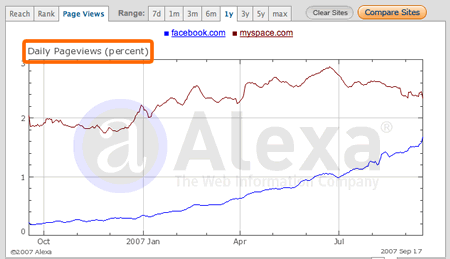Should designers optimize for page views…or user experience?
An interesting quote from Facebook’s founder Mark Zuckerberg, when asked if Facebook’s news feed feature, which aggregates disparate profile information into a single view, reduces page views (and presumably advertising revenue).
“our thinking is that if we give people more controls, they can share more information. As people shared more and more information, Facebook found that it creates a more component experience that brings them back to Facebook more often. Page views and traffic went up 50% within weeks of the launch of the news feed.”
Wow, that stat is amazing. A simple interface design feature, thought (by traditional thinking) to decrease page views, actually increased them and fast.

Page Views vs. User Experience
Zuckerberg’s response underlines a real distinction between the old page view approach to the Web and the new user experience approach. The difference lies in what you optimize for…
An interesting quote from Facebook’s founder Mark Zuckerberg, when asked if Facebook’s news feed feature, which aggregates disparate profile information into a single view, reduces page views (and presumably advertising revenue).
“our thinking is that if we give people more controls, they can share more information. As people shared more and more information, Facebook found that it creates a more component experience that brings them back to Facebook more often. Page views and traffic went up 50% within weeks of the launch of the news feed.”
Wow, that stat is amazing. A simple interface design feature, thought (by traditional thinking) to decrease page views, actually increased them and fast.

Page Views vs. User Experience
Zuckerberg’s response underlines a real distinction between the old page view approach to the Web and the new user experience approach. The difference lies in what you optimize for.
If you optimize for page views, you’re going to make decisions, both strategic and tactical, that increase page views. This results in things like split-stories on news sites, way too many screens on social networking sites, and perhaps worst of all, an entire approach focused on “keeping people on the site”. The problem with this approach is that it quickly gets out of hand. Instead of providing a single value proposition, the site provides countless propositions, thus diluting the value of each one. In almost all cases of optimizing for page views, the experience of the user takes a back seat. You optimize for the quarterly numbers, not user satisfaction.
If you optimize for the user experience, on the other hand, you have to take a longer approach. Sure, you might not get as much advertising revenue in the short term as the site with more page views, but you’re adding more long-term value. That’s the road that Facebook is taking, at least up until now. They don’t need to be worried about page views because they’re adding users and users are building out their social graphs on the site. (however, Facebook is currently building an advertising platform that could change this).
In other words, if Zuckerberg and Facebook had been stuck in the page view way of thinking, they never would have implemented the news feed feature. It simply makes viewing the activity of others too easy…there is no clicking necessary. But, the insight they had was that giving people better views into information would actually make the service more valuable and thus indirectly do what others fear would have suffered…increasing page views!
The problem with many sites these days is that they’re optimized for the advertiser and thus page views, not the user and their experience. What smart sites like Facebook see is that giving people tools they can really use is the best way forward because it makes them happy customers who will return again and again and over time you’ll get a lot more value out of that than if you optimized for anything else.
How AJAX/DHTML leads to less Advertising
This is the battlefield where interface design smacks head-on into advertising. It has become the 800lb gorilla in the room of many sites who rely on advertising revenue. In many cases, using technology and design to reduce the number of screens (either by simplifying task flows or by using AJAX/DHTML) drastically reduces page views that bring in advertising revenue.
Thus, it has become a very real issue that when designers do their job well, a site will generate less advertising revenue as a result…at least in the short term. Many folks in the advertising business stop at this point and push harder and harder for more page views. It may not always be apparent, but page views are still solidly entrenched in many boardroom strategy talks as the one metric to optimize.
In the long term, however, an enhanced user experience will actually drive more ad revenue because it will make people more successful, the service more valuable, and people will be more willing to share with others. They’ll return more, be happier, and eventually provide more revenue either directly or indirectly as a result of good business.
The question is: are decision-makers willing to adapt to this new way of thinking? Or is it just folks like Mark Zuckerberg, who didn’t come from the culture of page views, who can successfully optimize for user experience above all else?